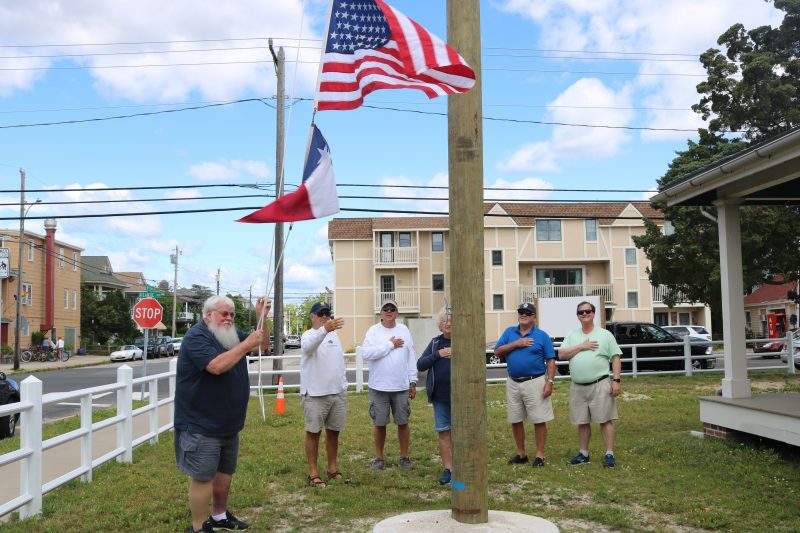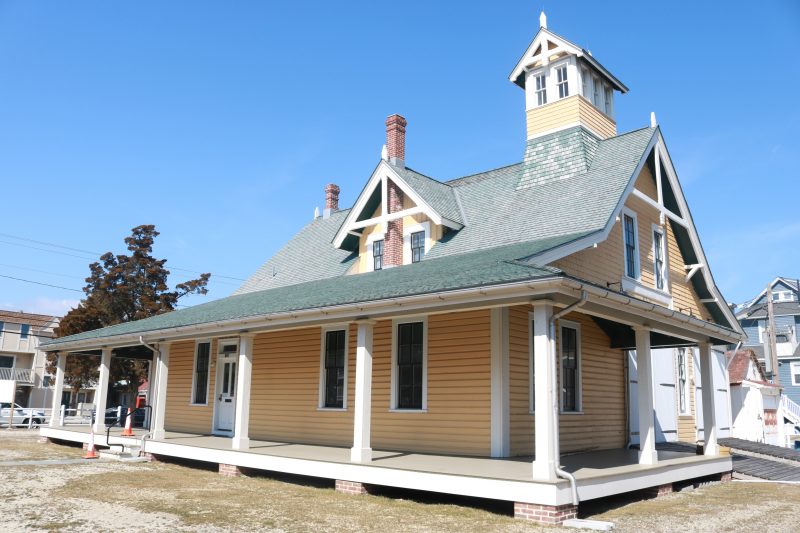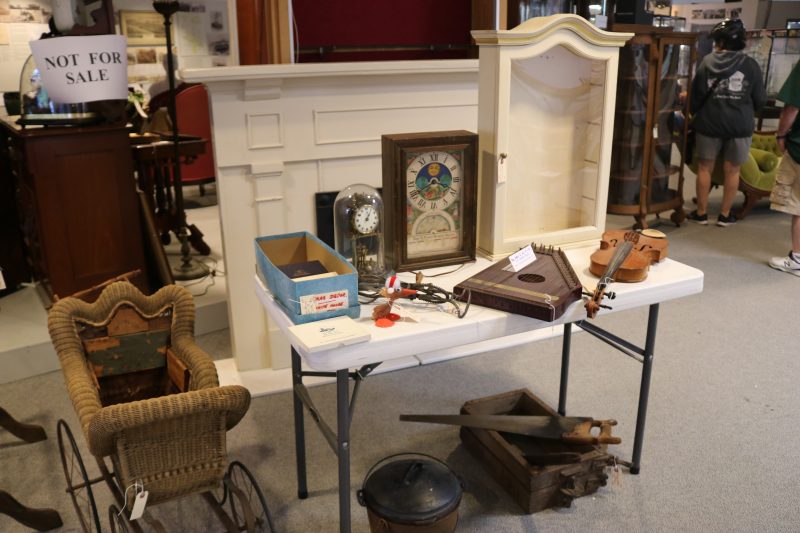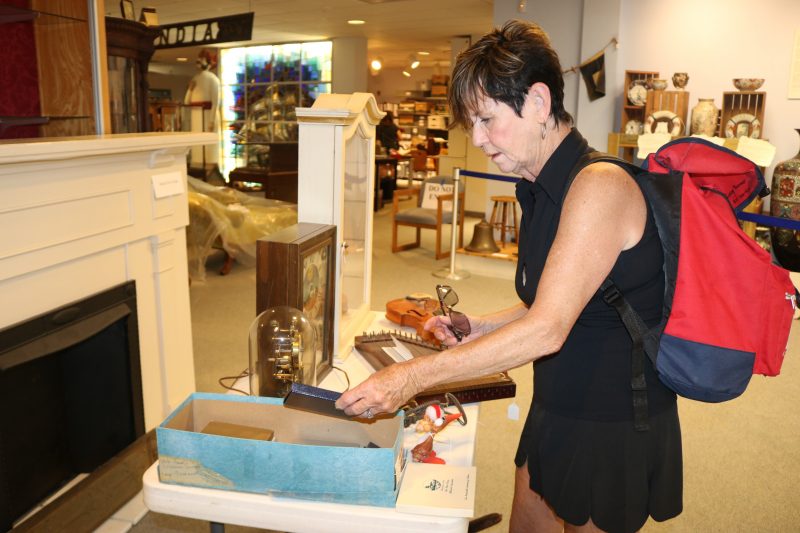John Loeper raises the flag recently at the U.S. Life Saving Station 30.
 Maddy Vitale
Maddy Vitale
History was made yet again at the Ocean City U.S. Life-Saving Station 30 on Friday morning. A flag flew for the first time since 1915 on Flag Day.
“It has been 104 years since a flag flew at the Life-Saving Station,” said John Loeper, chairman of U.S. Life-Saving Station 30. “I think having the flagpole is like icing on the cake.”
During a ceremony with a handful of locals present, including historian Fred Miller, Loeper did the honors of the traditional raising of the colors at the station, which also showcases replica items such as the ones when it was in service.

This library box is a reproduction of the ones used to transfer books from Life-Saving Stations so that the surf men and keeper could have something to read.
“This is a sign of the rebirth of the Life-Saving Station,” Miller noted. “It is wonderful and appropriate that it was on Flag Day.”
The 57-foot-high flagpole was put in with some help from the community. Ocean City businessman Scott Halliday, owner of Halliday Leonard, donated the pilings for the flagpole.
“It’s a very traditional pole. It looks like a mast of a Navy ship,” Loeper said.
The station, located at Fourth Street and Atlantic Avenue, formally opened to the public as a museum last year to showcase Ocean City’s history with the U.S. Life-Saving Service, the forerunner to the U.S. Coast Guard.
As ship travel expanded in the early 19th century, the government made passenger safety a higher priority. The U.S. Life-Saving Service, a government agency, was formed in 1848 to rescue shipwrecked passengers and crew members. It was the predecessor to the U.S. Coast Guard, which was created in 1915.

Dating to the late 1800s, the U.S. Life-Saving Station has been converted into a museum.
Ocean City’s station was occupied by the Life-Saving Service until 1915. The Coast Guard took over then and continued to use it for life-saving operations until the 1940s. It was then sold to private owners and became a residence. A succession of owners had it as their private home for decades before the city acquired it in 2010, beginning the process for the building’s conversion into a museum.
In addition to the flagpole, there were some interesting items in the Life-Saving Station museum.
The museum features old photographs of some of the surf men, furniture of the time and kitchenware. It also showcases a replica lifeboat, and two new additions, including a livery boat circa the 1800s.
Loeper noted that with the flagpole and additions to the inside of the historic building now in place, the vital piece of Ocean City’s history is really coming together.

Museum goers had plenty of antiques to choose from at the sale.
The flag-raising ceremony was one of two events Friday organized by the Ocean City Historical Museum showcasing historical artifacts and antiques.
The tag sale runs through Saturday.
People could purchase antiques that were donated to the museum, but ones that museum officials said were either duplicates of items already showcased there, or just not desired for display. Curios, large couches, a typewriter, a wicker doll carriage, pictures, clocks and other items, some dating back to the 1800s, were available for purchase.
Carol Dotts, interim executive director of the Ocean City Historical Museum, said of the sale, “Over the years we have had items donated to the museum. The idea is, if it didn’t fit with the history of the museum, we could sell it. The turnout for the sale has been exceptional.”

Gerry Bonner, of Ocean City, checks out some of the antiques for sale.
Museum guests browsed the items on sale.
“I just can’t believe the things they have. I was hoping to find an old map,” said Ocean City resident Gerry Bonner.
There was even a Victorian “fainting couch” that dates back to 1880.
Stephen Gring, a member of the museum board of trustees who is in charge of the Antiques Fair in the Community Center in July, called the response to the first sale “overwhelming.”
“We had an overwhelming and successful sale,” Gring said. “This is the first day of it and all of the proceeds go to the museum’s curatorial efforts. We are all grateful for the public’s support.”

Stephen Gring takes a seat on a Victorian "fainting couch."
 Maddy Vitale
History was made yet again at the Ocean City U.S. Life-Saving Station 30 on Friday morning. A flag flew for the first time since 1915 on Flag Day.
“It has been 104 years since a flag flew at the Life-Saving Station,” said John Loeper, chairman of U.S. Life-Saving Station 30. “I think having the flagpole is like icing on the cake.”
During a ceremony with a handful of locals present, including historian Fred Miller, Loeper did the honors of the traditional raising of the colors at the station, which also showcases replica items such as the ones when it was in service.
Maddy Vitale
History was made yet again at the Ocean City U.S. Life-Saving Station 30 on Friday morning. A flag flew for the first time since 1915 on Flag Day.
“It has been 104 years since a flag flew at the Life-Saving Station,” said John Loeper, chairman of U.S. Life-Saving Station 30. “I think having the flagpole is like icing on the cake.”
During a ceremony with a handful of locals present, including historian Fred Miller, Loeper did the honors of the traditional raising of the colors at the station, which also showcases replica items such as the ones when it was in service.
 This library box is a reproduction of the ones used to transfer books from Life-Saving Stations so that the surf men and keeper could have something to read.
“This is a sign of the rebirth of the Life-Saving Station,” Miller noted. “It is wonderful and appropriate that it was on Flag Day.”
The 57-foot-high flagpole was put in with some help from the community. Ocean City businessman Scott Halliday, owner of Halliday Leonard, donated the pilings for the flagpole.
“It’s a very traditional pole. It looks like a mast of a Navy ship,” Loeper said.
The station, located at Fourth Street and Atlantic Avenue, formally opened to the public as a museum last year to showcase Ocean City’s history with the U.S. Life-Saving Service, the forerunner to the U.S. Coast Guard.
As ship travel expanded in the early 19th century, the government made passenger safety a higher priority. The U.S. Life-Saving Service, a government agency, was formed in 1848 to rescue shipwrecked passengers and crew members. It was the predecessor to the U.S. Coast Guard, which was created in 1915.
This library box is a reproduction of the ones used to transfer books from Life-Saving Stations so that the surf men and keeper could have something to read.
“This is a sign of the rebirth of the Life-Saving Station,” Miller noted. “It is wonderful and appropriate that it was on Flag Day.”
The 57-foot-high flagpole was put in with some help from the community. Ocean City businessman Scott Halliday, owner of Halliday Leonard, donated the pilings for the flagpole.
“It’s a very traditional pole. It looks like a mast of a Navy ship,” Loeper said.
The station, located at Fourth Street and Atlantic Avenue, formally opened to the public as a museum last year to showcase Ocean City’s history with the U.S. Life-Saving Service, the forerunner to the U.S. Coast Guard.
As ship travel expanded in the early 19th century, the government made passenger safety a higher priority. The U.S. Life-Saving Service, a government agency, was formed in 1848 to rescue shipwrecked passengers and crew members. It was the predecessor to the U.S. Coast Guard, which was created in 1915.

 Museum goers had plenty of antiques to choose from at the sale.
The flag-raising ceremony was one of two events Friday organized by the Ocean City Historical Museum showcasing historical artifacts and antiques.
The tag sale runs through Saturday.
People could purchase antiques that were donated to the museum, but ones that museum officials said were either duplicates of items already showcased there, or just not desired for display. Curios, large couches, a typewriter, a wicker doll carriage, pictures, clocks and other items, some dating back to the 1800s, were available for purchase.
Carol Dotts, interim executive director of the Ocean City Historical Museum, said of the sale, “Over the years we have had items donated to the museum. The idea is, if it didn’t fit with the history of the museum, we could sell it. The turnout for the sale has been exceptional.”
Museum goers had plenty of antiques to choose from at the sale.
The flag-raising ceremony was one of two events Friday organized by the Ocean City Historical Museum showcasing historical artifacts and antiques.
The tag sale runs through Saturday.
People could purchase antiques that were donated to the museum, but ones that museum officials said were either duplicates of items already showcased there, or just not desired for display. Curios, large couches, a typewriter, a wicker doll carriage, pictures, clocks and other items, some dating back to the 1800s, were available for purchase.
Carol Dotts, interim executive director of the Ocean City Historical Museum, said of the sale, “Over the years we have had items donated to the museum. The idea is, if it didn’t fit with the history of the museum, we could sell it. The turnout for the sale has been exceptional.”
 Gerry Bonner, of Ocean City, checks out some of the antiques for sale.
Museum guests browsed the items on sale.
“I just can’t believe the things they have. I was hoping to find an old map,” said Ocean City resident Gerry Bonner.
There was even a Victorian “fainting couch” that dates back to 1880.
Stephen Gring, a member of the museum board of trustees who is in charge of the Antiques Fair in the Community Center in July, called the response to the first sale “overwhelming.”
“We had an overwhelming and successful sale,” Gring said. “This is the first day of it and all of the proceeds go to the museum’s curatorial efforts. We are all grateful for the public’s support.”
Gerry Bonner, of Ocean City, checks out some of the antiques for sale.
Museum guests browsed the items on sale.
“I just can’t believe the things they have. I was hoping to find an old map,” said Ocean City resident Gerry Bonner.
There was even a Victorian “fainting couch” that dates back to 1880.
Stephen Gring, a member of the museum board of trustees who is in charge of the Antiques Fair in the Community Center in July, called the response to the first sale “overwhelming.”
“We had an overwhelming and successful sale,” Gring said. “This is the first day of it and all of the proceeds go to the museum’s curatorial efforts. We are all grateful for the public’s support.”
 Stephen Gring takes a seat on a Victorian "fainting couch."
Stephen Gring takes a seat on a Victorian "fainting couch."